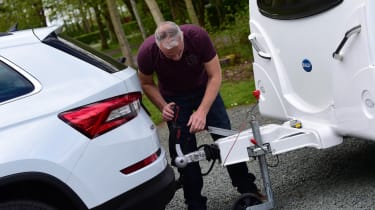Towing guide: UK laws, licences, capacities and top tips
Whether you’re towing a caravan, a trailer or even a boat, our towing guide explains how to do it

Whether you are planning to tow a caravan, a trailer, a horsebox, or a boat, it is important to understand what your driving licence entitles you to tow, the laws governing towing in the UK, and how to tow safely. Our complete guide to towing in the UK covers it all with towing weights and capacities covered on page two.
Towing licence rules: what can you legally tow in the UK?
In December 2021, the law was changed to allow more drivers to legally tow trailers without any added categories on their licence or the need to take a towing test. Following that change, these are the current UK towing rules…
- If you passed your driving test before 1 January 1997
You are allowed, in most cases, to drive a vehicle and trailer combination up to 8,250kg MAM. You’re also allowed to drive a minibus with a trailer over 750kg MAM. - If you passed your driving test after 1 January 1997
You are allowed, in most cases, to tow a trailer up to 3,500kg MAM. You can drive a vehicle weighing up to 3500kg and a vehicle/trailer combination up to 6,750kg.
Prior to the 2021 rule change, drivers who passed their test after 1997 would have had to undergo additional training and pass a dedicated car and trailer test if they wished to tow anything heavier than 750kg. However, this test is no longer required.

As a result of the rule change, whenever drivers who passed their test after 1997 receive a new driving licence - such as when you renew or change your details - category BE will be added to it. In the meantime, your current licence will still qualify you for this category, even if it isn’t physically marked.
Towing a heavier vehicle and trailer combination: what do you need?
If you need to tow a load that’s heavier than what your standard licence allows, you will need to hold a category C1E licence - this allows you to drive medium-sized vehicles between 3,500 and 7,500kg MAM (with a trailer up to 750kg). The combined MAM of both must not exceed 12,000kg. If towing this sort of vehicle and trailer combination is for work, you will also need a Driver Certificate of Professional Competence.
Towing safely and legally
When towing on public roads, if you are deemed to be doing so in an unsafe manner you could be prosecuted and liable for a large fine, penalty points or even a driving ban. Therefore, it is important to take every step you can to ensure that you are as safe as possible. Be sure to remember the following:
- If you are purchasing a tow bar for your car, it must be type-approved - this means that it has been approved for use in the UK and EU and is suitable for your vehicle. This does not apply, however, if the vehicle was first used before 1 August 1998.
- It is also important to fit extended towing mirrors if your rear visibility is obstructed - such as when towing a horsebox or a caravan. If you fail to do so you could be fined up to £1,000 and receive 3 penalty points on your licence.
- A number plate also needs to be fitted to the trailer, and this must match the towing vehicle’s registration number at all times.
- A trailer, caravan, horsebox or anything being towed must have a full set of working lights. This includes tail lights, indicators, fog light, number plate lights, and red triangle reflectors. Trailers that are 2.55-metres wide must also have reflectors on the rear corners.
- Trailer weighing more than 1,020kg require an annual MoT test just like any car that’s three-years old or more. Lighter trailers do not need this inspection, but it’s a good idea to have them checked. The law also says it’s your responsibility to make sure the trailer is in a safe roadworthy condition.
- If you are loading the trailer, caravan, horsebox etc. ensure that this weight is evenly spread out as this will help to avoid unstable handling and any excessive wear on the wheels and tyres.
- The maximum length for a trailer towed by a vehicle weighing up to 3,500kg is 7 metres.
- The maximum width for a trailer towed by any vehicle is 2.55 metres.
- If you are towing a US-made caravan or trailer, make sure it complies with European safety regulations.
Towing Speed limits
Different speed limits may apply when you are towing, these are the current restrictions.
As normal, the usual speed limit of 30 miles per hour applies to all single and dual carriageways with street lights, unless there are signs showing otherwise. However, in other situations, the following limits apply to a car towing a trailer:
- Built-up areas 30mph
- Single carriageways 50mph
- Dual carriageways 60mph
- Motorways 60mph
Towing a caravan
There are a few extra things to consider when towing your home from home.
Just as you would with a standard trailer, you must be sure of the caravan's weight, which can add up to a significant amount when it’s fully loaded. To make things a bit easier, this should be displayed on a plate or in the caravan’s handbook.
When measuring the total weight of the caravan, you will need to include any luggage in the caravan. You will also need to include the weight of luggage and occupants in the car when working out the MAM (Maximum Authorised Mass) for towing. If you think that you are particularly close to your car’s maximum towing capacity, it could be a wise move to get a more accurate figure using a dedicated measurement tool or using an online calculator.
In some cases, a caravan’s Maximum Authorised Mass (MAM) might instead be referred to as its Maximum Technically Permissible Laden Mass (MTPLM). This is the maximum permitted weight when all furnishings and luggage are on board.
Towing training courses
While the car and trailer driving test is no longer a legal requirement, the DVSA is urging drivers to still seek training before towing for safety reasons. It certainly isn’t a bad idea to get some lessons to not only boost your towing safety, but also your confidence. Fortunately, there are a number of private driving schools and other organisations that still offer towing courses.
If you are unsure of any rules that apply to towing on UK roads, you can find further information at Gov.uk.
Common towing terms explained
- Towing capacity: the maximum amount of weight your car can safely and legally tow.
- Maximum Authorised Mass (MAM): the weight of a vehicle or trailer including the maximum load that can be carried safely when on the road. This can also sometimes be referred to as gross vehicle weight (GVW) or permissible maximum weight.
- Maximum Technically Permissible Laden Mass (MTPLM): an alternative term for the MAM of a caravan with all luggage and furnishings on board.
- Gross Vehicle Weight (GVW): the maximum your car can weigh when fully loaded with occupants and luggage.
- Gross Train Weight (GTW): the maximum combined weight of the car and trailer/caravan including people and luggage.
- Mass in Running Order (MIRO): – the caravan’s weight in the manufacturer’s standard spec.
- Unladen weight: the weight of a vehicle that isn’t carrying any passengers or luggage. Other variables such as fuel are also not taken into account.
- Unbraked trailer: A trailer without its own braking system.
- Braked trailer: A trailer with its own braking system.
- Noseweight: The weight of your caravan and its contents on the tow ball
- Snaking: An unstable side-to-side movement made by the caravan, sometimes caused by wind.
Frequently Asked Questions
Not any more in the UK. Since December 2021, all drivers can tow a trailer or caravan without sitting a special test. Drivers who passed their test before 1 January 1997 can tow with a vehicle weighing up to 7,500kg and a maximum vehicle/trailer combined weight of 8,250kg.
Those who passed their test after 1 January 1997 can tow with a vehicle weighing up to 3,500kg and a maximum combined vehicle/trailer weight of 6,750kg. There is no need to update your driving licence as this applies to all drivers and your licence will be updated automatically when it’s next renewed.
Need a new car to tow with? Read our list of the best new tow cars on sale now...
Find a car with the experts



